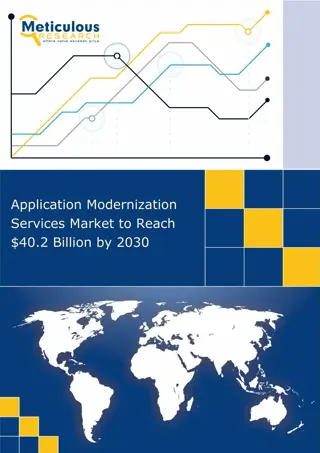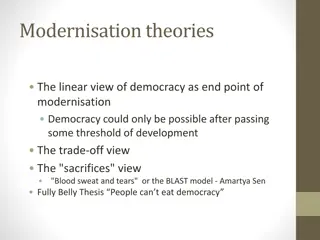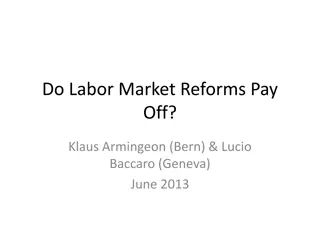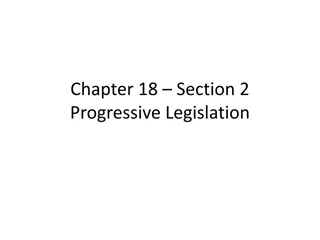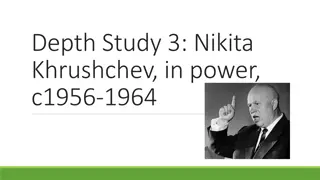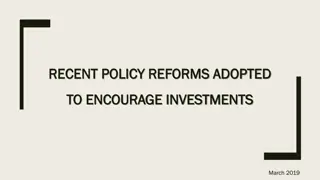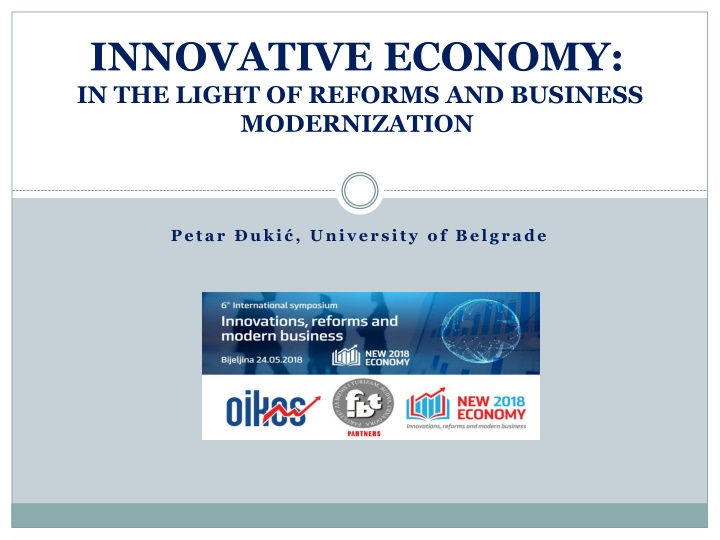
Innovative Economy in Light of Reforms & Modernization
Delve into the concept of the innovative economy through discussions on controversies, institutions, risks, and necessary adjustments. Explore the evolution of modern business, the role of innovations, reforms, and the quest for competitiveness in a global landscape. Gain insights into the theoretical evaluation of the new economy and the perspectives of Balkan and related nations on technological readiness, business sophistication, and innovation indices.
Download Presentation

Please find below an Image/Link to download the presentation.
The content on the website is provided AS IS for your information and personal use only. It may not be sold, licensed, or shared on other websites without obtaining consent from the author. If you encounter any issues during the download, it is possible that the publisher has removed the file from their server.
You are allowed to download the files provided on this website for personal or commercial use, subject to the condition that they are used lawfully. All files are the property of their respective owners.
The content on the website is provided AS IS for your information and personal use only. It may not be sold, licensed, or shared on other websites without obtaining consent from the author.
E N D
Presentation Transcript
INNOVATIVE ECONOMY: IN THE LIGHT OF REFORMS AND BUSINESS MODERNIZATION Petar uki , University of Belgrade
Contents of Innovation Controversies Institutions and innovations Risks to innovations and necessity of adjustment Inequality Incentives to innovations - innovation bureaucracy Social and political contents of innovations
NOTION , DISTINCTION AND GOALS New economy modern business Could modern business exist without innovations and reforms - all over the world? Modernisation (tehnology + structutural changes) = Innovative economy from the beginning of technology era (1750-th) New economy (NE) - explains the substantial redefintion of the structure of production factors end of XX century New economy conceptualization: innovation invention - technology change - structural change -new cultural model of society Every systematic economy once was new . The beginning NE: from agricultural revolution 12.000 years ago
Theoretical evaluation of new economy" First ideas of (enterpreneurial) innovations: Cantillon, Smith, Say, Marx, Marshall, Schumpeter, Drucker... Knowledge and innovations - led to income growth technological improovement - "theory of endogenous technology changes + stimulation of institutions (Tobin, Samuelson, Nordhouse, Carillo...) Exemples: the basic level, and later relative development of the similar economies (Mexico, Brazil, China, South Corea) Value of work by our 60- tih i 2000: - 60-th: differences not significant - finish XX cenuty: in Corea (thanks to education) $9 dolara, per our; - in Mexico and Brazil no more than $ 2 dolar, (in China $ 0,6). But China now is the bigest national economy in the world, more developed than Serbia and Montenegro (with GDP per cap) little bit lower than in Croatia. Howe? The simple answer is: beter competitiveness in long-term sence- knovledge and education expandion. Lets see next indicators:
Balkan and related nations 140 120 100 80 60 40 20 0 Serbia 78 72 110 95 Montenegro 77 48 101 91 BiH 103 69 115 123 Albania 75 81 74 87 Slovenia 48 35 41 35 Poland 39 47 57 59 China 28 73 33 28 Japan 9 15 3 8 General rank Tehnol. rediness (2) Business sophistication (3) Inovations (4) Comparative indicators faktors competitiveness (GCI) by WEF 2017/2018 which showes parspectives of innovative economy concept and practice
Global Competitiveness Ranks from WEF 2017/18 Gen. rank 2017. (1) Rank Techno readiness (2) Business sophisticati on rank (3) Innovation s rank (4) Average (2,3,4) (1)/ average (2,3,4) Income per cap. Croatia 74 72 82 106 94 0.78 12095.2 Serbia 78 48 110 95 102.5 0.82 5376.3 77 69 101 91 96 0.84 Montenegr o BiH 6628.6 103 81 115 123 119 0.86 4308.2 Albania 75 35 74 87 80.5 0.93 4203.4 Slovenia 48 47 41 35 38 1.26 21320 Poland China Japan 39 28 9 73 15 15 57 33 3 59 28 8 58 0.66 0.91 1.63 12350 8113 38717.3 30.5 5.5 Comparative indicators of global competitiveness rank. Significant ratio of certain countries, of the sophistication factor rank, and business innovation, in comparison with the income per capita
Income Dependency on Innovation and Technological Performances, for selected Countries 2017/18 (WEF) Income (Poland=1) Innov. and tech. perform (ITP) ITP/GCI 5.7 4.5 4.13 4.1 3.95 3.9 3.73 3.6 3.6 3.16 1.73 1.03 1 1 0.97 0.96 0.92 0.92 0.9 0.88 0.87 0.82 0.66 0.54 0.43 0.35 0.34 Croatia Serbia Montenegro BiH Albania Slovenia Poland China Japan Incomeconditions the technological and innovational performances of the economy. Command economy inheritance causes lesser applicability of the realized innovations, the existing business sophistications and technological readiness. Slovenia is the most successful, next to Japan. Source: GCI WEF 2017/2018, and author s calculation
RISCS OF THE INNOVATIVE ECONOMY Aldos Haksly: the idea of new society in which the man is nothing and the system is everything Musolini repeats: The man is nothing, the state is everything . Totalitarizm of knowledge and technology transits in totalitarizm of the state, knowledge and i technology Toffler ( Future Shock , 1972) the option of revolutionary transition from industrial to super- industrial society because of too rapid changes in too short intervals : - problem of adaptability - differences and traits of global inequalities - intergeneration gap
Income Differences and Growth Quality GINI changes 1990-2000 80 70 60 50 40 30 20 10 0 Russian Federation 39.5 43 South Africa Brazil Argentina China India Indonesija OECD 1990 2000 68 69.5 61 54 45 46 33 41 32.5 38 39 37 29 32 Inequality increased rapidly from 90-th. Especially in the countries exposed to reforms, as well as in OECD economies. The global researches of Stiglitz, Piketi, Milanovi shows that inequality becomes the river with no return . Milanovic noticed even so-called residential rent .
Innovation economy and developing countries Innovations advantages are not reserved only for the high tech area. They strongly approves export, based on knowledge and innovation: Example: fish from Uganda, wine from Argentina and Chile, as well as medical plants from India. Malaysia develops and exports palm oil and derivates. The innovations in informal sector need the reforms Researches and development in agro-economy have huge influence on poverty reduction, even more that all public investments (OECD) It is necessary to support the growth, and the innovations. They need: the institutions and legal state; democratic controle, free media and the stimulative culture. Cultural innovations in non-governmental sector is needed. Green innovations special importance for the development of tourism, education, energy efficiency, green building and transport, new habits and lifestyles.
Goals off Democracy Reforms in Selected Transiotion Countries (29) 8 7 6 5 4 3 2 1 0 2008 4.11 3.79 3.64 6.82 1.93 2009 4.18 3.79 3.71 6.86 1.93 2010 4.25 3.71 3.71 6.89 1.96 2011 4.32 3.64 3.64 6.93 1.93 2012 4.36 3.64 3.61 6.93 1.93 2013 4.39 3.64 3.61 6.93 1.96 2014 4.43 3.64 3.68 6.93 1.96 2015 4.46 3.68 3.68 6.93 1.96 2016 4.5 3.75 3.68 6.93 1.93 2017 4.54 3.82 3.71 6.93 1.93 BiH Serbia Croatia Uzbekistan Estonia Reform success grades according to Freedom House for the group of chosen countries in transition. Most successful: Estonia (1.93) and the lowest Uzbekistan (6.9)
Inclusive Development Indicators new from WEF Growth and development: BDP per capita, employment, work productivity, quality of health life expecatitions; median income family, power rate; Inclusicity: income inequality - GINI, equity inequality- GINI; Intergeneration justice and sustainability: adjusted neto saving, public death ratio in GDP; dependency ratio; carbon intensity Preliminary results: GDP growth in 43% of analyzed countries has not brought inclusive social development progress. -Proincluzive: Cambodia, the Czech Republic, New Zealand, the Republic of Korea, and Viet Nam - Insufficiently inclusive : Brazil, Ireland, Japan, Mexico, Nigeria, South Africa, United States
Complx. three basic pillars of our central subject teme: inovations, reforms and modern business What are changes today? Law of life in biological, social, technology sence. So we have: the innovative society, person, business, culture or not. It depends on reforms: what about, and what to do with? 1. The innovations and reforms coases modern technologies 1. Sustainability of developmental processes are the in focus of innovations 3. The goal: from innovations throw reforms to successful business and society
Traditional and modern technologies / technology era FROM THE OLD PAST Non progredi est regredi Not to strive means to regress. Romman proverb. It means the need to be: new, opened, progressive, proactive - to know, to learn, to research But old Romans did not know for: glassesand stirrup, (very simple things that could make easier their lives). They used to use lead (extremely toxic metal material) for the plates for dishes, for water system, cups for wine. TODAY DILEMAS - What does mean modern or postmodern technologies? More sciences and les simple and hazardous expiriences and traditional practice.
Technology Goals - From the Begeenig to the Present Time Tehnological era begun 250 years ago with woter steem usage. - The main goala were to: better use natural resources, produce more, and les coastl (steem engine, railwais, telephone, internal combustion engines, electrical machines). - Later: the modern technologies became a paradigm of the knowledge, the science, progress. But they are realised mostly as of numerous and big public or private projects. - Nowadays : the postmodern technologies are based on innovations, knowledge, education evrery where. Not only in real secter, manufacturing, not even in the economic sector in general. The main goals : create new resources, to save nature and ecosystems, to prototect environmant, to face the climate changet, to emprouve humen life, save the Planet
SERBIAN- BALKAN CASE: FROM ENERGY TECHNOLOGIES, ACROSS INOVATIONAS AND ECONOMIC DEVELOPMENT TO CLIMATE CHANGES INNOVATION N. Tesla (1846-1943) progress metaphor picture up. Serbian- Croat and American energy scientist - inventor, electrical engineer, phycisist, and futurist, contributed to the designe of modern alternating current (AC) electrical Supply System . Mihajlo Pupin Serbian-American physicist and physical chemist. Numerous patents, including a means of greatly extending the range of long-distance, telephone communication by placing lauding coils (of wire) at predetermined intervals along the transmitting wire (known as "pupinization") Milutin Milankovic, down theory of long/term climate cyclus: The Canon of the Earth s Insolation which characterizes all the planets of the Solar system - theoretical explanation of the changes caused by the astronomical changes in the position of the Earth in relation to the Sun; today known as Milankovic cycles . All exemples are important to easier face the climate changes - bigest long-term challenge of human rase.
Conclusions Innovative and creative (new) economy nowadays could be found every where about, not only in area of high technology Reforms are necessary to generate sustainable growth, and innovative and inclusive development Innovations can be successfully stimulated by bettering (inclusive) institutions, legal state, democracy, cultural and education policies Innovations are awfully needed to face the future of climate changes and other substantial challenges of human race.
Thank you for your attention!


